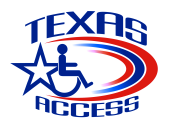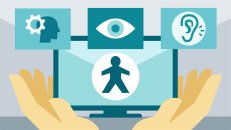Multimedia- meaning more than one type of media has always been used to achieve a specific function. It combines multiple media such as text, audio or music, images (including infographics), video, or animation. Multimedia now plays a vital role in this digital age and serves as an excellent way to communicate and hold attention and interest in measurable benefits easily. They also aid information retention and are useful for educational purposes, at home, in public spaces, and in business as an online marketing tool.
The multi-dimensional use of multimedia necessitates their importance to ensure everyone can access information. Inaccessible multimedia will turn into persons with disabilities who can’t hear, see, interact, or even understand it. Images, video, slides, and audio content without alternatives are useless to people with auditory or visual disabilities since the accessibility barriers won’t allow them since they can’t access it. Yet, video remains a top priority for marketers. According to the 2020 Wyzowl’s State of Video Marketing Survey, 85% of businesses now use video as a marketing tool. Even more, it currently serves as an integral part of the consumer journey with brands, with more than half of the consumers wanting to see more video content from their favorite brands. Given the report was compiled before the coronavirus outbreak, all signs suggest that users will likely be more and are on course to continue their growth in 2021 since there has been a heavy reliance on business activities on the internet.
The use of multimedia presents opportunities, no doubt, but as big as it sounds; they somewhat remain underutilized without considering alternatives for disabled persons. The CDC reports that over 61 million American adults live with a disability– more than 20% of the population. If we add this to another 20% of the aging population suffering from low vision acuity, color blindness, or hard of hearing due to aging, the chances are dramatically reduced.
Don’t get me wrong. This is not a call for organizations to stop integrating multimedia into marketing or information materials; rather, it is a call for organizations to make multimedia accessible to people with disabilities and expand the reach of such media to everyone. Like having accessible documents, having accessible multimedia contributes to web accessibility and hence, ADA, Section 508, and EN 301 549 compliance. Web content accessibility (including multimedia) can be achieved by following the recognized Web Content Accessibility Guidelines (WCAG) 2.1.
To save you the stress, below are tips for your content creators to ensure multimedia content is accessible to persons with disabilities.
Alternative Text
Alternative text (alt-text) or alternative attribute (alt attribute) is a word or phrase that provides alternative information about an image or graphic. Alt-text is useful for users with visual impairments (such as low vision and blindness) who typically rely on changing the presentation into forms that are more usable for their particular needs, such as screen readers that provide a text-to-speech synthesis of the content.
Alt-text is also beneficial to anyone with a slow connection or low bandwidth. The user cannot view the image to enable them to understand the image’s content (photos, infographics, or charts).
| Bad (ALT text: A man) | Good (ALT text: Barack Obama – Former U.S President) |
|---|---|
 |
 |
Captions
Captions are generally synchronized text equivalent to the spoken audio from an audio or video (or animations) content. They are usually displayed at the same time as the audio from the video they correspond to. Captions provide text information about what’s happening in the video to ensure people with auditory impairments such as those “hard of hearing” or “deafness” can read through to access the information. The caption should identify speakers, background sounds, and other information being conveyed in the audio or video content.
Captions can also be vital for non-native speakers who would listen to the content and at the same time like to see the text or slang (in which dialogues are spoken) they can’t hear or understand, such as scientific or medical terms. The same reason makes them beneficial to people with cognitive, learning, and neurological disabilities that impact how well people hear, move, or see.
Captions should be legible by having a sufficient color contrast between the foreground and background colors.

The above image is a screenshot from a YouTube video showcasing captions explaining the message on the screen.
Text Transcripts
Text transcripts are written-out versions of audio or video content. It consists of all the verbatim dialogues that are being said by the speakers in the audio or video file and descriptions of on-screen titles and other critical video content. Transcripts are essential for people with hearing impairments and “deaf-blind” users who use screen readers to understand the multimedia file’s content.
Where captions are essential for video content, transcripts are necessary for audio content. Like it is for captions, it is also vital for transcripts to have good color contrast between text and the background and the right font style and size to ensure readability.
Text transcripts have multi-dimensional use. They are useful for anyone looking to get specific information without taking the time to listen to the entire audio file or watch the whole video. They also help low-bandwidth users who can’t watch the video with the content.
Audio Descriptions
Audio Description is an audio narration that describes actions, scenes, and other vital contexts that are visually presented in the video. Audio descriptions are mainly useful for people with visual disabilities (blind or low vision) to ensure they capture the dialogue visually presented in the video when the regular soundtrack doesn’t provide enough information.
An example is a movie scene where a dog is barking. The sighted users can see the dog barking at a long snake’s sight, which means they understand the context and content. Non-sighted users won’t know the visible part of the scene (the long snake); all they learn from the audio is a barking dog. This gap is what audio descriptions address.
Audio descriptions also help users with cognitive disabilities such as Autism Spectrum Disorder (ASD) who have difficulty interpreting visual information or social communication like facial expressions. It can also be useful for non-disabled people who want to watch the video while multitasking, with their eyes not focused on the video.
Audio Control
Audio control is merely ensuring the web user has an easy mechanism to control audio volume independently from the overall system volume level. The web user can pause, stop, or control the volume of the sound without having to turn down the entire system’s volume.
Audio control specifically helps people with visual impairments who use the screen reader to listen to the web page. The ability to control the sound will ensure they can turn down the sound volume without turning down the screen reader’s volume, hence preventing sound interference. Audio control also helps anyone who finds the audio sound distracting.
Multimedia Accessibility as part of Compliance
Providing alternatives (captions, alt text, audio descriptions, and text transcripts) to your multimedia is the key to making them accessible to all users and ensuring an inclusive experience. Accessible multimedia will contribute to overall user experience and web traffic (text transcripts, captions, and alt text) from increased search engine rankings and expanded user base. Importantly, multimedia accessibility will ensure your organization achieves and maintains compliance with web accessibility laws.







